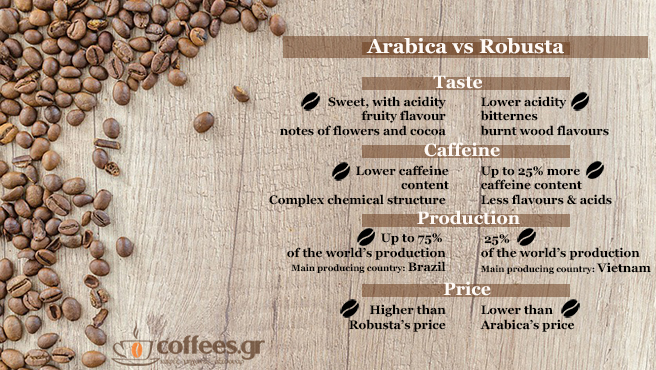Arabica or Robusta ;

The audience to which coffee addresses to have become more and more informed - and therefore, more demanding. One of the first things to know when entering in the magical world of coffee is the difference between the two basic varieties of coffee : Arabica and Robusta.
Arabica and Robusta are the two basic varieties of coffee sold nowadays throughout the world, with their names corresponding to the Coffea Arabica and Coffea Canephora coffee plants respectively. Although belonging to the same family, the two plants, and hence the produced coffee beans, bare significant differences.
Which are the main differences between Arabica & Robusta ;
- Flavor: As it comes to taste, Arabica is superior to Robusta. Generally, it is characterized by its intense sweetness, its increased acidity and a wide aromatic spectrum that often carries notes of fruit, flowers and cocoa. Robusta, on the other hand, is usually bitterer, carrying scents of earth and nuts - or even burned rubber, as many tend to say.
- Caffeine content: Arabica generally has significantly lower caffeine content than Robusta, at rates that can reach as much as 25%.
- Production: 75% of world coffee production is Arabica, when Brazil holds the scepters of Arabica production. The remaining 25% of the world coffee production is Robusta and is mainly produced in Vietnam.
- Cultivation: Robusta is significantly more resistant than Arabica to diseases and pests and its cultivation is less painful. Robusta also thrives at lower altitudes, unlike Arabica, which also makes its cultivation easier.
- Price: Due to its quality and the different cultivation conditions, Arabica is generally more expensive than Arabica.

More information on Arabica & Robusta
- While Arabica coffee is widely considered superior to Robusta, the final quality of the product depends on many factors, such as the the way of cultivation and the processing methods used. A good, well-crafted and quality Robusta coffee can be better than an Arabica coffee that is produced without the necessary quality standards.
- Being classified as Arabica does not mean that a coffee is quality coffee – after all, 70-75% of world production belongs to this variety.
- Robusta grains are widely used for instant coffee production, because of their lower price and their ability to producea thicker cream.
- Robusta coffee tends to make enjoyable espresso cups, due to its strength, strong body and thick cream. A nice blend to try a quality 100% Robusta blend is Vending Gusto Forte by Lavazza.
- The special properties of Robusta grains make them an indispensable complement to many espresso blends as they improve the cream and add strength to the coffee. The mixing ratio varies, but most of the time it is around 70/30 (70% Arabica and 30% Robusta). Two typical examples of that blending ratio, that combines all the fine characteristics of both blends, are Extra Bar by Portioli and Premium by Buondi.
- Specialty coffee blends are almost exclusively from 100% Arabica grains. There are lots of quality options in 100% arabica blends, like Sant' Eustachio, which comes from the heart of Rome, and Superior from the Napolitan brand Kimbo.
Choosing the right coffee blend depends on our personal taste. There are coffee enthusiasts who prefer lighter, fragrant coffee blends, while others choose coffees with strength and bitterness. If you are not sure about your personal taste yet, make experiments by tasting different coffees - your coffee trip will be interesting and exciting. If you have any questions, just ask us - we well be more than glad to give you directions and advices in finding the coffee that suits you.










